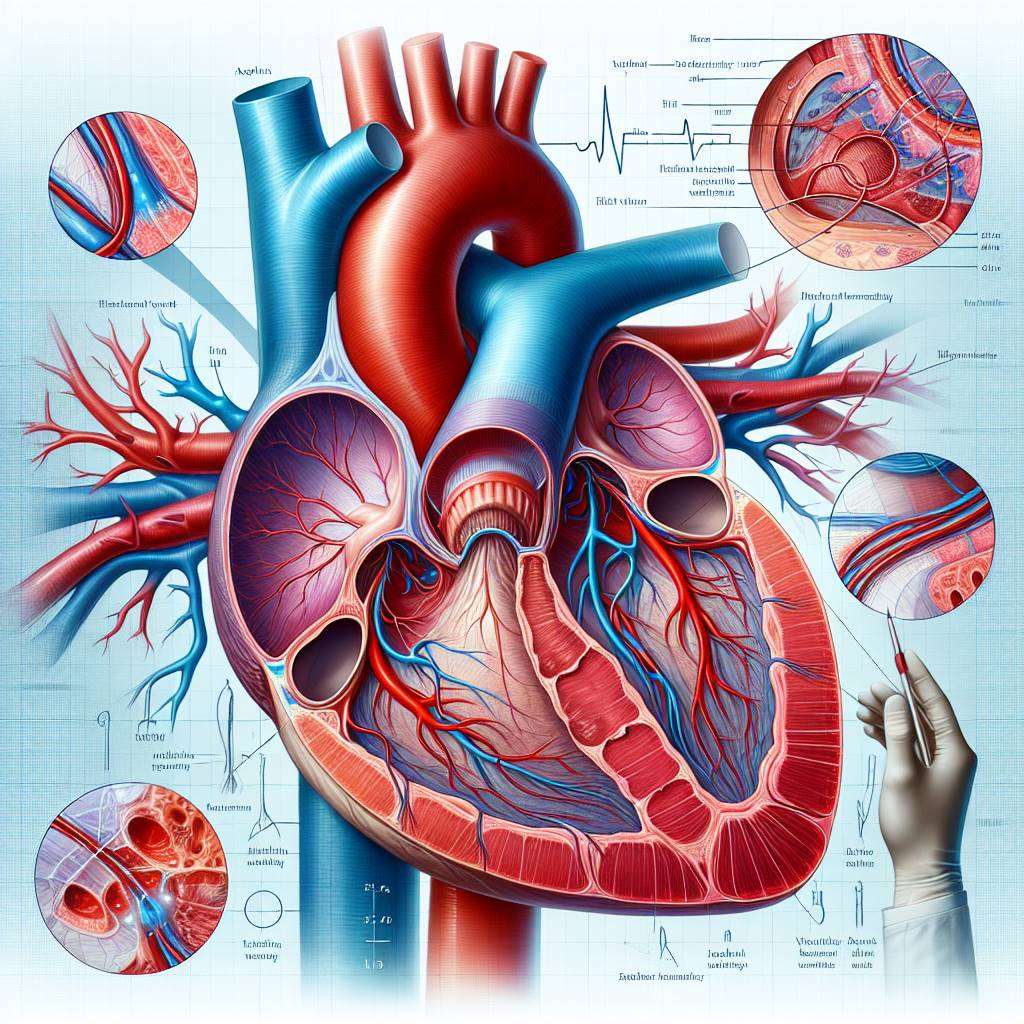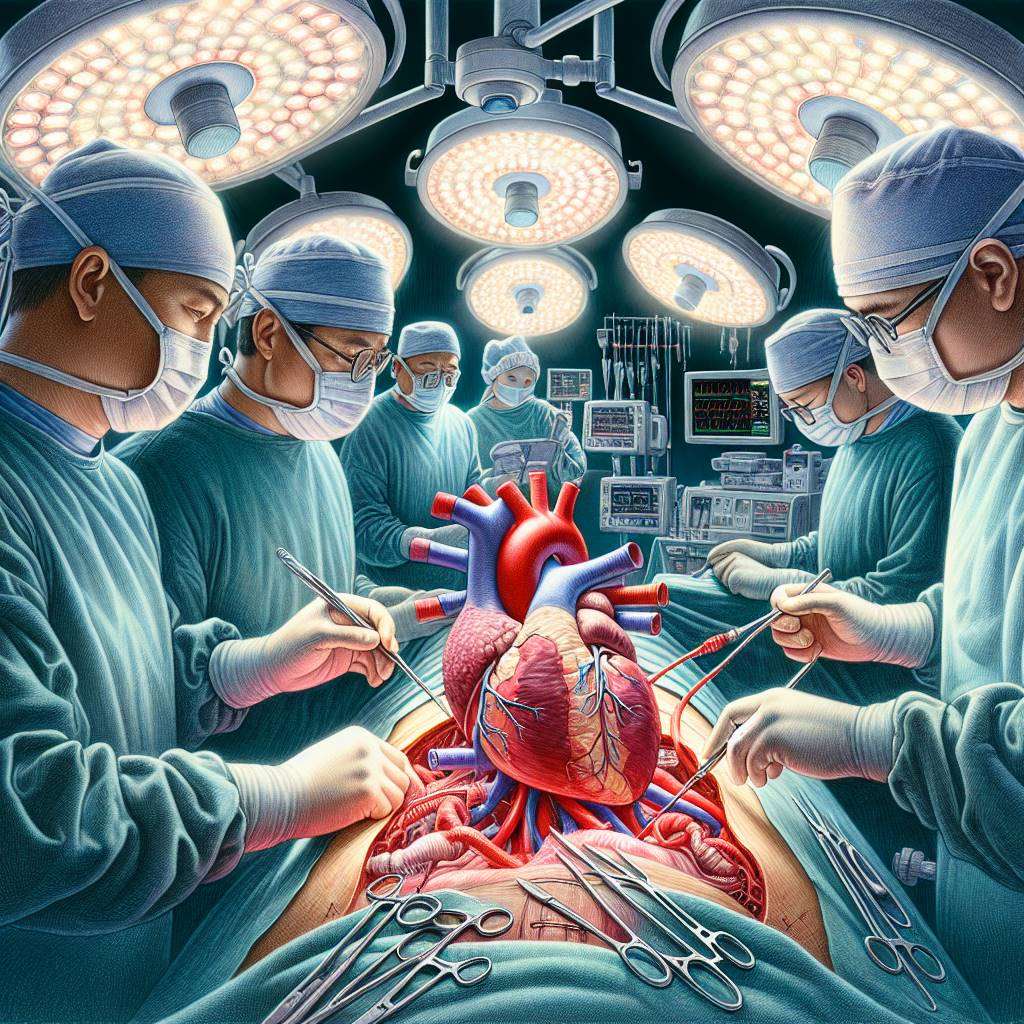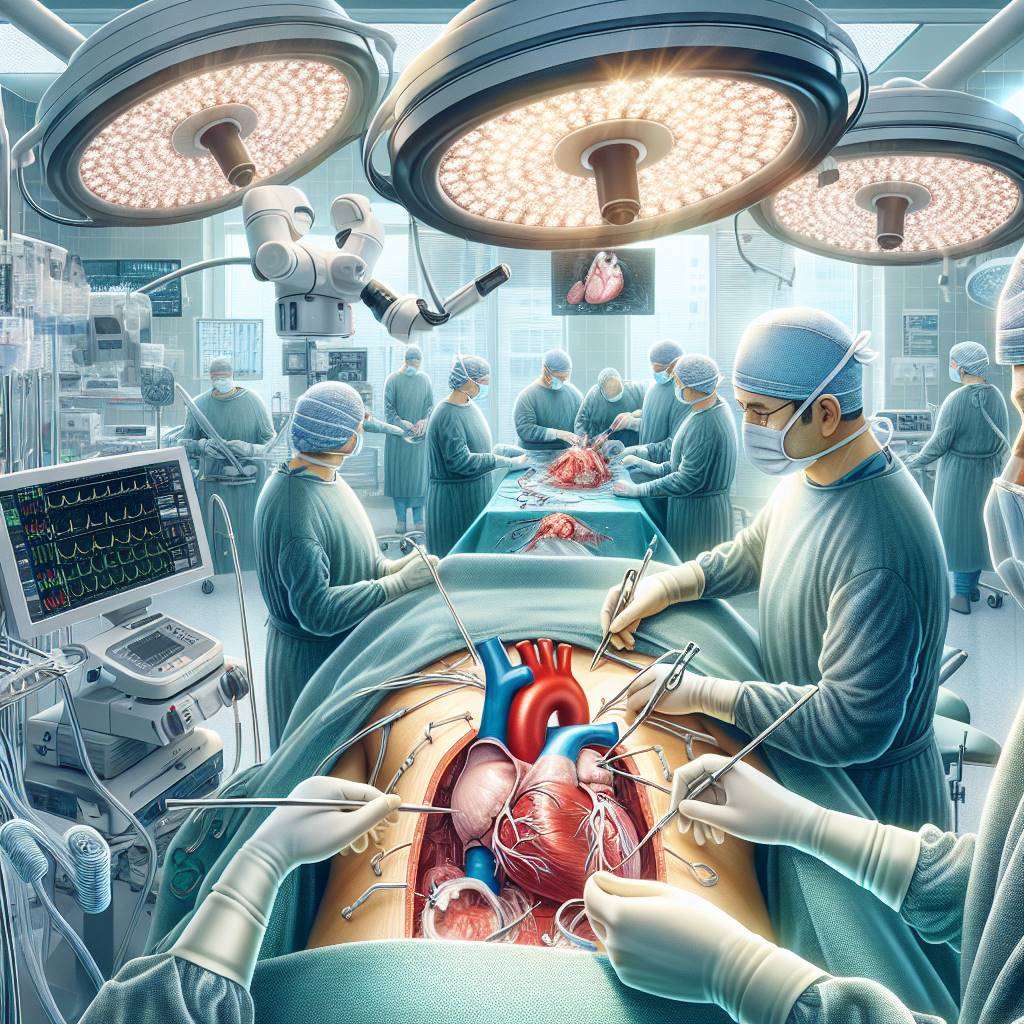The mitral-aortic valve continuity refers to the anatomical and functional connection between the mitral valve and the aortic valve in the heart. This region plays a critical role in maintaining proper blood flow and heart function. Understanding this connection is essential for diagnosing and treating valvular heart diseases, which can significantly impact a patient’s quality of life.
From a surgical perspective, the mitral-aortic valve continuity is crucial during procedures like valve replacement or repair. Its unique structure and proximity to other cardiac components make it a key focus for surgeons. Awareness of this area helps in managing conditions such as aortic stenosis or mitral regurgitation, ensuring better outcomes for patients.
What Is Mitral-Aortic Valve Continuity? Explained Simply
The mitral-aortic valve continuity is the anatomical region where the mitral valve and aortic valve are connected. This area is formed by a fibrous structure called the aortomitral curtain, which ensures a seamless transition of blood flow from the left atrium to the left ventricle and then into the aorta. It is a vital component of the heart's structure and function.
This connection plays a key role in maintaining the efficiency of the heart's pumping mechanism. Any disruption in this continuity, such as due to congenital defects or acquired diseases, can lead to significant cardiac complications. Understanding this area is essential for both cardiologists and surgeons to ensure accurate diagnosis and effective treatment.
For patients, issues in this region can manifest as symptoms like shortness of breath, fatigue, or chest pain. Early detection and management are crucial to prevent further complications.

Anatomy of the Mitral-Aortic Valve: Key Insights
The anatomy of the mitral-aortic valve continuity is complex yet fascinating. The mitral valve, located between the left atrium and left ventricle, works in tandem with the aortic valve, which regulates blood flow from the left ventricle into the aorta. The fibrous aortomitral curtain connects these two valves, ensuring structural integrity and functional harmony.
This region is surrounded by critical structures, including the left coronary artery and the conduction system of the heart. Any surgical intervention in this area requires a detailed understanding of its anatomy to avoid complications. For instance, damage to the conduction system during surgery can lead to arrhythmias.
The table below highlights the key components of the mitral-aortic valve anatomy:
| Component |
Function |
| Mitral Valve |
Regulates blood flow between the left atrium and left ventricle |
| Aortic Valve |
Controls blood flow from the left ventricle to the aorta |
| Aortomitral Curtain |
Provides structural continuity between the two valves |
Why Mitral-Aortic Valve Continuity Matters in Surgery
The mitral-aortic valve continuity is a critical consideration during cardiac surgeries, especially valve replacement or repair procedures. Its proximity to vital structures like the coronary arteries and conduction pathways makes it a challenging area for surgeons. Any damage to this region can lead to complications such as arrhythmias or impaired blood flow.
Surgeons must carefully assess the condition of the aortomitral curtain and surrounding tissues before performing procedures. Advanced imaging techniques, such as echocardiography and CT scans, are often used to visualize this area in detail. These tools help in planning surgeries and minimizing risks.
For patients, understanding the importance of this region can help in making informed decisions about surgical options. Discussing potential risks and benefits with a cardiac surgeon is essential for achieving the best outcomes.
Understanding the Role of Mitral-Aortic Valve in Heart Function
The mitral-aortic valve continuity plays a pivotal role in maintaining efficient heart function. It ensures the smooth transition of blood from the left atrium to the left ventricle and then into the systemic circulation via the aorta. This seamless flow is vital for delivering oxygen-rich blood to the entire body.
Any disruption in this continuity can compromise heart function, leading to conditions like heart failure or valvular insufficiency. For example, a weakened aortomitral curtain may result in blood leakage or regurgitation, reducing the heart's efficiency.
Maintaining the integrity of this region is essential for overall cardiovascular health. Regular check-ups and early intervention can help in managing potential issues effectively.
Common Disorders Affecting Mitral-Aortic Valve Continuity
Several disorders can affect the mitral-aortic valve continuity, leading to significant health challenges. Common conditions include aortic stenosis, mitral regurgitation, and infective endocarditis. These disorders can disrupt the structural and functional harmony of the heart, causing symptoms like breathlessness, fatigue, and chest pain.
Congenital defects, such as a bicuspid aortic valve, can also impact this region. Infections or degenerative changes may weaken the aortomitral curtain, leading to complications. Early diagnosis through imaging and clinical evaluation is crucial for effective management.
- Aortic Stenosis: Narrowing of the aortic valve, restricting blood flow.
- Mitral Regurgitation: Leakage of blood back into the left atrium.
- Infective Endocarditis: Infection of the heart valves and surrounding tissues.
Treatment options vary based on the condition and severity, ranging from medication to surgical intervention. Consulting a cardiologist is essential for personalized care.
How Surgeons Approach Mitral-Aortic Valve Repair
The mitral-aortic valve continuity is a critical anatomical structure that connects the mitral and aortic valves. During surgical procedures, maintaining this continuity is essential to ensure proper heart function. Surgeons often approach this repair with precision, focusing on preserving the structural integrity of the valves.
One common technique involves the use of bioprosthetic materials to reconstruct damaged areas. In cases of severe damage, a complete valve replacement may be necessary. Surgeons must also consider the patient's overall health, including the presence of conditions like aortic stenosis or mitral regurgitation, which can complicate the procedure.
Post-surgery, patients are closely monitored for complications such as valve leakage or infection. The success of the surgery often depends on the surgeon's expertise and the use of advanced tools like 3D imaging for precise planning.

Mitral-Aortic Valve Continuity: Diagnostic Techniques and Tools
Accurate diagnosis of mitral-aortic valve continuity issues is crucial for effective treatment. Cardiologists rely on a combination of advanced diagnostic tools to assess the structure and function of these valves. One of the most commonly used techniques is echocardiography, which provides detailed images of the heart's anatomy and blood flow.
Other diagnostic tools include cardiac MRI and CT scans, which offer high-resolution images to identify abnormalities. In some cases, invasive procedures like cardiac catheterization may be performed to measure pressures within the heart chambers and evaluate valve function.
- Echocardiography: Non-invasive and widely used.
- Cardiac MRI: Provides detailed soft tissue imaging.
- CT Scans: Useful for structural assessment.
- Cardiac Catheterization: Measures heart pressures directly.
These tools help in identifying conditions such as aortic insufficiency or mitral valve prolapse, enabling timely intervention and better outcomes.
Advanced Imaging for Assessing Mitral-Aortic Valve Integrity
Advanced imaging techniques have revolutionized the assessment of mitral-aortic valve integrity. Among these, 3D echocardiography stands out for its ability to provide real-time, three-dimensional views of the heart. This technology allows cardiologists to visualize the valves' structure and function in unprecedented detail.
Another cutting-edge tool is cardiac CT angiography, which combines CT imaging with contrast dye to highlight blood flow and detect blockages or structural defects. Similarly, cardiac MRI offers superior soft tissue contrast, making it ideal for evaluating complex cases.
These imaging modalities are particularly useful in pre-surgical planning, helping surgeons identify the exact location and extent of damage. By leveraging these technologies, healthcare providers can ensure more accurate diagnoses and tailored treatment plans for conditions like valve stenosis or regurgitation.
Challenges in Surgery Involving Mitral-Aortic Valve Continuity
Surgical procedures involving mitral-aortic valve continuity are highly complex and present several challenges. One major difficulty is maintaining the delicate balance between the two valves while ensuring proper blood flow. Surgeons must also address any underlying conditions, such as rheumatic heart disease or congenital defects, which can complicate the surgery.
Another challenge is the risk of complications, including valve thrombosis, infection, or structural failure of the repaired valve. To mitigate these risks, surgeons often use advanced techniques like minimally invasive surgery or robotic-assisted procedures, which offer greater precision and reduced recovery times.
Post-operative care is equally critical, as patients may require long-term monitoring and medications to prevent complications. Despite these challenges, advancements in surgical techniques and technology continue to improve outcomes for patients undergoing these complex procedures.
Mitral-Aortic Valve Continuity in Congenital Heart Defects
Congenital heart defects often involve abnormalities in the mitral-aortic valve continuity, posing unique challenges for both diagnosis and treatment. Conditions like atrioventricular septal defects or tetralogy of Fallot can disrupt the normal alignment and function of these valves.
In pediatric patients, early diagnosis is crucial to prevent complications such as heart failure or growth delays. Surgical intervention is often required to correct these defects, with procedures tailored to the patient's age and specific condition. For example, neonates may undergo staged surgeries, while older children might benefit from complete repair in a single operation.
| Condition |
Treatment Approach |
| Atrioventricular Septal Defect |
Valve reconstruction or patch repair |
| Tetralogy of Fallot |
Complete surgical repair |
By addressing these congenital issues early, healthcare providers can significantly improve the quality of life and long-term outcomes for affected individuals.
Minimally Invasive Options for Mitral-Aortic Valve Surgery
Minimally invasive surgical techniques for the mitral-aortic valve are transforming patient outcomes. These procedures involve smaller incisions, reducing recovery time and minimizing risks. Surgeons use advanced tools like robotic systems to enhance precision and safety.
Patients undergoing minimally invasive surgery often experience less postoperative pain and shorter hospital stays. Techniques such as transcatheter aortic valve replacement (TAVR) and minimally invasive mitral valve repair are becoming more common. These approaches are particularly beneficial for elderly patients or those with comorbidities who may not tolerate open-heart surgery well.

Post-Surgical Care for Mitral-Aortic Valve Procedures
Proper post-surgical care is critical for patients recovering from mitral-aortic valve surgery. After the procedure, patients are closely monitored for complications such as infection, bleeding, or arrhythmias. Early detection of these issues can significantly improve outcomes.
Rehabilitation includes regular follow-ups with a cardiologist, medication management, and lifestyle changes. Patients are often prescribed anticoagulants to prevent blood clots and may need to adhere to a low-sodium diet to reduce strain on the heart.
- Attend all scheduled follow-up appointments.
- Take medications as prescribed by your doctor.
- Engage in light physical activity as recommended.
Understanding Mitral-Aortic Valve Continuity in Valve Replacement
The mitral-aortic valve continuity is a crucial anatomical structure that connects the mitral and aortic valves. This area plays a vital role in maintaining the heart's structural integrity and ensuring efficient blood flow between the left ventricle and the aorta.
During valve replacement surgeries, preserving or reconstructing this continuity is essential to prevent complications such as paravalvular leaks or impaired cardiac function. Surgeons often use advanced imaging techniques like echocardiography to assess the continuity before and after surgery.
Understanding this anatomical feature helps in tailoring surgical approaches, especially in complex cases involving both valves. It ensures better long-term outcomes for patients undergoing valve replacement procedures.
How Mitral-Aortic Valve Continuity Affects Blood Flow Dynamics
The mitral-aortic valve continuity significantly influences blood flow dynamics within the heart. This structure ensures seamless coordination between the mitral and aortic valves, allowing efficient blood ejection from the left ventricle into the aorta.
Disruption in this continuity, whether due to congenital defects or surgical complications, can lead to turbulent blood flow, increased cardiac workload, and reduced oxygen delivery to the body. Patients may experience symptoms like fatigue, breathlessness, or chest pain.
Advanced diagnostic tools, including Doppler echocardiography, are used to evaluate blood flow patterns and detect abnormalities. Addressing these issues promptly through surgical or medical interventions is crucial for restoring normal heart function.
Future Innovations in Mitral-Aortic Valve Surgery
Advancements in mitral-aortic valve surgery are paving the way for improved patient care. Emerging technologies like 3D printing and artificial intelligence are helping surgeons plan and execute complex procedures with greater accuracy.
One promising innovation is the development of bioengineered valves, which aim to mimic natural valve function while reducing the risk of rejection. Additionally, hybrid procedures that combine open and minimally invasive techniques are gaining popularity for their versatility and effectiveness.
| Innovation |
Benefits |
| 3D Printing |
Customizes surgical planning and improves outcomes. |
| Bioengineered Valves |
Reduces rejection risk and enhances durability. |
| Hybrid Procedures |
Combines the best of open and minimally invasive techniques. |
Best Mitral Valve Replacement Surgery Doctors in India
Two highly reputed doctors specializing in Mitral-Aortic Valve Continuity Treatment in India are Dr. Naresh Trehan, Chairman and Managing Director at Medanta - The Medicity, Gurugram, with over 40 years of experience and international recognition, and Dr. Devi Prasad Shetty, Founder of Narayana Health, Bengaluru, a renowned cardiac surgeon with over 35 years of expertise. Both are globally acclaimed for their excellence in cardiac surgery.
Learn more on best mitral valve replacement surgery doctors in india
Best Mitral Valve Replacement Surgery Hospitals in India
Leading hospitals for Mitral-Aortic Valve Continuity Treatment in India include Fortis Escorts Heart Institute, New Delhi, known for its advanced cardiac care and NABH accreditation, and Apollo Hospitals, Chennai, a JCI-accredited facility offering cutting-edge robotic surgery and multidisciplinary care. Both hospitals provide international patient services and have a track record of successful outcomes in complex cardiac surgeries.
Find more best mitral valve replacement surgery hospitals in india
Mitral Valve Replacement Surgery Cost in India
The cost of Mitral-Aortic Valve Continuity Treatment in India typically ranges between INR 3,50,000 to INR 7,00,000 (approximately USD 4,200 to USD 8,500). Factors influencing the cost include the surgeon’s expertise, hospital category, and procedure complexity. The average hospital stay is 5-7 days. India offers a significant cost advantage compared to Western countries, with options for medical insurance and third-party financing.
Learn mitral valve replacement surgery cost in india
Mitral Valve Replacement Surgery Treatment in India
Mitral-Aortic Valve Continuity Treatment in India involves advanced surgical techniques, including open-heart surgery or minimally invasive approaches such as robotic-assisted procedures. The surgery typically includes valve repair or replacement, ensuring optimal blood flow. Recovery timelines range from 4-6 weeks. Top hospitals in India adopt global medical protocols and innovative technologies, ensuring high success rates and patient safety.
Learn on Mitral Valve Replacement Surgery Treatment in India
FAQs
What is the significance of mitral-aortic valve continuity?
The mitral-aortic valve continuity is a structural connection between the mitral and aortic valves. It plays a crucial role in maintaining the integrity of the heart's left ventricular outflow tract and ensuring efficient blood flow from the heart to the body.
What conditions can affect the mitral-aortic valve continuity?
Conditions such as aortic stenosis, mitral regurgitation, endocarditis, and congenital heart defects can disrupt the mitral-aortic valve continuity, leading to impaired cardiac function.
How is mitral-aortic valve continuity assessed?
It is assessed using advanced imaging techniques like echocardiography, CT scans, or cardiac MRI, which provide detailed views of the heart's structure and function.
What surgical options are available for mitral-aortic valve continuity issues?
Surgical options include valve repair, valve replacement, or reconstructive procedures to restore the continuity and functionality of the valves.
What are the risks associated with mitral-aortic valve surgery?
Risks may include bleeding, infection, arrhythmias, or complications related to anesthesia. However, advancements in surgical techniques have significantly reduced these risks.
How long does recovery take after mitral-aortic valve surgery?
Recovery typically takes 4-6 weeks, depending on the patient’s overall health, the complexity of the procedure, and adherence to post-operative care guidelines.
Can mitral-aortic valve issues be treated without surgery?
In some cases, medications or minimally invasive procedures like transcatheter valve replacement may be viable alternatives to surgery, depending on the severity of the condition.
Are robotic-assisted surgeries available for mitral-aortic valve treatment in India?
Yes, many top hospitals in India offer robotic-assisted surgeries, which are minimally invasive, reduce recovery time, and enhance surgical precision.
Is mitral-aortic valve surgery safe for elderly patients?
Yes, with proper pre-operative evaluation and advanced surgical techniques, mitral-aortic valve surgery can be safely performed in elderly patients, ensuring improved quality of life.
What lifestyle changes are recommended after mitral-aortic valve surgery?
Patients are advised to follow a heart-healthy diet, engage in regular physical activity, avoid smoking, and adhere to prescribed medications to maintain optimal heart health post-surgery.
Innovations in Mitral Valve Repair: TEER and Robotic Surgery
Mitral valve repair techniques have evolved significantly, offering patients safer and more effective treatment options. One of the most notable advancements is the Transcatheter Edge-to-Edge Repair (TEER), which provides a minimally invasive alternative to traditional surgical methods. This technique differs from Transcatheter Mitral Valve Replacement (TMVR) by focusing on repairing the existing valve rather than replacing it entirely. To learn more about these differences, check out our detailed blog on TEER and TMVR.
In addition to TEER, robotic surgery is revolutionizing the field of mitral valve repairs by enhancing precision and reducing recovery times. This advanced technology allows surgeons to perform intricate procedures with greater accuracy, minimizing the impact on surrounding tissues. For insights into how robotic surgery is transforming mitral valve repairs, explore our blog on robotic surgery advancements.
These innovations not only improve patient outcomes but also pave the way for future developments in cardiac care, making it an exciting time for both patients and healthcare professionals.